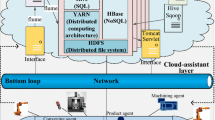Abstract
The quality control of sub-assemble products (SAP) in a distributed manufacturing shop (DMS) becomes crucial and complicated when the production of SAPs involves a variety of production technology. In this case, traditional statistical process control methods are not sufficient to control such manufacturing system. Here, we design an intelligent web information system, where quality data are collected from DMS and stored in the central database. The processes of manufacturing SAPs in DMS are then controlled by clustering homogenous SAPs using the quality control of SAP in DMS (QCSD) and process smoothness factor based SAP predefined clustering (PSFSPC) algorithms, respectively. A prototype system called an intelligent web information system quality control (IWIS-QC) has been developed to trace the quality profiles of SAPs. Finally, a case study has been presented to illustrate and validate the proposed approach.
Similar content being viewed by others
Abbreviations
- FAP:
-
Final assemble product
- SAP:
-
Sub-assemble products
- DMS:
-
Distributed manufacturing shop
- Q :
-
The number of sub-assemble products
- M :
-
The number of attributes
- L :
-
The number of locations
- T :
-
Time period duration
- K :
-
The number of process
- SAP lrk ::
-
The sub-process k of the sub-assemble product r in distributed manufacturing shop l
- \({\mathop M\nolimits_{kt}^{lr} (i)}\) :
-
Quality measurement, at time t in distributed manufacturing shop l for process k of the sub-assemble product r on attribute i
- \({\mathop \alpha \nolimits_{lrki}^t \quad}\) :
-
Quality value, at time t in distributed shop l for process k of the sub-assemble product r, on attribute i
- \({\mathop \Theta \nolimits_k^{lr} (i)}\) :
-
Quality mean value for process k of the sub-assemble product r in distributed shop l on attribute i
- \({\mathop \Theta \nolimits_k^r (i)}\) :
-
Quality mean value for process k of the sub-assemble product r on attribute i
- \({\mathop \Phi \nolimits^{lr} (i)}\) :
-
Quality mean value of the attribute i associated to the sub-assemble product r in distributed shop l
- \({\mathop \Phi \nolimits^r (i)}\) :
-
Quality mean value of the attribute i associated to the sub-assemble product r
- S l :
-
The number of sub-assemble products that could be produced in location l
- \({\mathop \Theta \nolimits_k^{lr} (i)}\) :
-
Quality mean value for each process of the SAP in DMS
- \({\mathop \Theta \nolimits_k^r (i)}\) :
-
Quality mean value for each process of the SAP all over the company
- \({\mathop \Phi \nolimits^{lr} (i)}\) :
-
Quality mean value for each attribute in DMS
- \({\mathop \Phi \nolimits^r (i)}\) :
-
Quality mean value for each attribute all over the company
- \({\mathop \omega \nolimits^{lr} (i)}\) :
-
Attribute/index smoothness factor
- \({\mathop \theta \nolimits_i^- }\) :
-
Lower attribute/index threshold value
- \({\mathop \theta \nolimits_i^+ }\) :
-
Upper attribute/index threshold value
- \({\mathop \psi \nolimits_k^{lr} (i)}\) :
-
Process smoothness factor
- \({\mathop \theta \nolimits_k^- }\) :
-
Lower process threshold values
- \({\mathop \theta \nolimits_k^+ }\) :
-
Upper process threshold values
- \({\mathop \mu \nolimits_k^{lr} (c)}\) :
-
Membership value for process k of the sub-assemble product r at cluster c
- \({\mathop \mu \nolimits^{lr} (c)}\) :
-
SAPs membership values to each cluster
References
Alojzij S., Peter B., Goran B. (1998) A multi-agent approach to process planning and fabrication in distributed manufacturing. Computers & Industrial Engineering 35: 455–458. doi:10.1016/S0360-8352(98)00132-6
Anderson J., Rungtusanatham M., Schroeder R.G. (1994) A theory of total quality management underlying the Deming management method. Academy of Management Review 3: 472–509. doi:10.2307/258936
Barkan P., Hinckley M. (1993) The benefits and limitations of structured design methodologies. ASME Manufacturing Review 6(3): 211–220
Beiter, K. A., Cheldelin, B., & Ishii, K. (2000). Assembly quality method: A tool in aid of product strategy, design, and process improvements. ASME Design Engineering Technical Conference, Baltimore.
Dean J.W., Snell S.A. (1991) Integrated manufacturing and job design: Moderating effects of organizational inertia. Academy of Management Journal 34: 776–804. doi:10.2307/256389
Eking, J. D. (1988). Quality costs. In J. M. Juran (Ed.), Juran’s quality control handbook, Section 4 (4th ed., p. 4.5). New York: McGrow-Hill.
Flynn B.B., Flynn E.J. (2005) Synergies between supply chain management and quality management: Emerging implications. International Journal of Production Research 43(16): 3421–3436. doi:10.1080/00207540500118076
Flynn B.B., Sakakibara S., Schroeder R.G. (1995) Relationship between JIT and TQM: Practices and performance. Academy of Management Journal 38(5): 1325–1360. doi:10.2307/256860
Mehra S., Hoffman J.M., Sirias P. (2001) TQM as a management strategy for the next millennia. International Journal of Operations & Production Management 21(5/6): 855–876. doi:10.1108/01443570110390534
Mehrabi M.G., Ulsoy A.G., Koren Y. (2000) Reconfigurable manufacturing systems: Key to future manufacturing. Journal of Intelligent Manufacturing 11(4): 403–419. doi:10.1023/A:1008930403506
Peklenik, J. (1992). FMS-A complex object of control. In Proceedings of the Eighth International Prolomat Conference, Tokyo, pp. 1–25.
Temponi C. (2006) Scalable enterprise systems: Quality management issues, International Journal of Production Economics 99(1–2): 222–235
Ueda, K. (1992) A concept for bionic manufacturing systems based on DNA-type information. In Proceedings of the Eighth International Prolomat Conference, Tokyo. pp. 53–864.1.
Van Brussel H., Wyns J., Valckenaers P., Bongaerts L., Peeters P. (1998) Reference architecture for holonic manufacturing systems: PROSA. Computers in Industry 37(3): 255–274. doi:10.1016/S0166-3615(98)00102-X
Warnecke H.J. (1993) Die Fraktale Fabrik, Revolution der Unternehmenskultur. Springer, Berlin
Yoshikawa, H. (1992). Intelligent manufacturing systems program (IMS). Technical cooperation that transcends cultural differences. Tokyo: University of Tokyo.
Author information
Authors and Affiliations
Corresponding author
Rights and permissions
About this article
Cite this article
Sahebjamnia, N., Mahdavi, I. & Cho, N. Designing a new model of distributed quality control for sub-assemble products based on the intelligent web information system. J Intell Manuf 21, 511–523 (2010). https://doi.org/10.1007/s10845-008-0210-5
Received:
Accepted:
Published:
Issue Date:
DOI: https://doi.org/10.1007/s10845-008-0210-5




